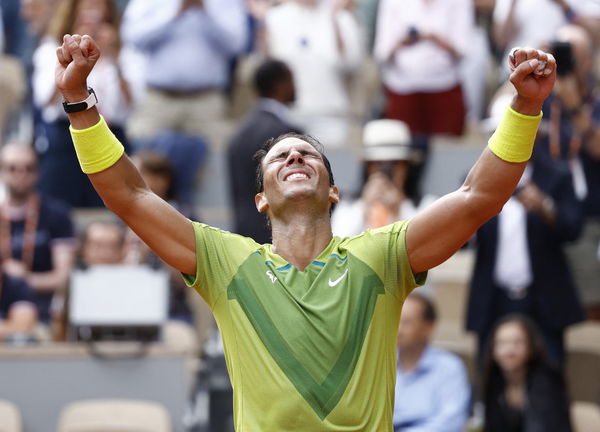
via Reuters
Tennis – French Open – Roland Garros, Paris, France – June 5, 2022 Spain’s Rafael Nadal celebrates winning the men’s singles final against Norway’s Casper Ruud REUTERS/Yves Herman

via Reuters
Tennis – French Open – Roland Garros, Paris, France – June 5, 2022 Spain’s Rafael Nadal celebrates winning the men’s singles final against Norway’s Casper Ruud REUTERS/Yves Herman
The French Open is one of the four Grand Slams in tennis. Along with Wimbledon, the Australian Open, and the US Open, it is one of the most prestigious tournaments in the sport. Every athlete who dreams of becoming a professional tennis player aims to lift the trophy at least once in his/her career. The clay major is something every tennis fan looks forward to watching.
Ever since it came into existence in 1891, the Paris tournament has seen several players participate and aspire to be their best players. However, no player in history has made the tournament their own like Rafael Nadal. The Spaniard holds the record for the most titles and the most consecutive titles at the French Open. Along with that, he has won 112 matches at Roland Garros, the record for the most wins at a grand slam.
ADVERTISEMENT
Article continues below this ad
Know how the prestigious French Open tournament came into existence
The very first French Open was played in 1891 on the courts of l’Ile de Puteaux. While only French players and players from the Francais clubs played in it, the first winner was a player of British origin, H. Briggs. The tournament was closed off to only men, but eventually integrated women in 1897. The first women’s French Open was won by Adine Masson.

The tournament was closed off to non-French residents for the first few decades. Players from other countries started playing in the championship in 1925. Even though the championship was open to the world, the first non-French player, Jack Crawford, wouldn’t win it till 1933. A similar trend would follow in the women’s division. The first international female player to win the French Open was Kea Bouman in 1927.
A history of the famous French Open stadium – Roland Garros
The French Open was first held in the courts of the l’Ile de Puteaux. Players would continue to play at the venue till 1924. In 1925, the Roland Garros Stadium was built to honor a fallen pilot. The stadium was named after a former member of the Francais club, Roland Garros. He was the first aviator who made the first non-stop flight across the Mediterranean Sea in 1913.

via Reuters
Tennis – French Open – Roland Garros, Paris, France – June 9, 2021 Spain’s Rafael Nadal celebrates winning his quarter final match against Argentina’s Diego Schwartzman REUTERS/Benoit Tessier
As World War I broke out, Garros joined the efforts with his compatriot. But his plane was unfortunately shot down in 1918, one day before his birthday. The stadium houses four courts, three of which are named after their legends. Court Philippe Chatrier is the main court which was named after the president of the Fédération Française de Tennis.
Read more – All You Need to Know About the Tennis Balls at French Open 2021
Court Suzanne Lenglen was named after the legendary tennis player whose career was highlighted by several accolades. The third court, Court Simonne Mathieu, was named after another legend of the championship and a leader of the French Resistance. The stadium also houses a museum called the Tenniseum, built in 2003.
All the French Open traditions
As is with several prestigious tournaments, the Roland Garros has several traditions put in place. The heritage of the championship has instructions which are followed each year without fail. A Children’s Day (Yannick Noah’s day) event is held before the tournament commences. Players also participate in exhibition matches which raise funds for charities.
Some of the most historic moments witnessed at the French Open
Having been in existence for well over a century, the Roland Garros has been home to some of the most iconic matches in tennis history. Most of the historic moments in the clay major have been due to the efforts of the Spaniard Rafael Nadal. While his moments are known too well, there are some lesser known to the current generation of tennis fans.

via Reuters
Tennis – French Open – Roland Garros, Paris, France – June 9, 2021 Serbia’s Novak Djokovic celebrates winning his quarter final match against Italy’s Matteo Berrettini REUTERS/Christian Hartmann
Andre Agassi clinching the trophy in 1999 became a historic comeback. After experiencing a major slump due to addiction and being absent from many major tournaments, Agassi’s French Open win was the first sign of his comeback. Similarly, the 1992 French Open women’s final became one of the most iconic moments in the tournament’s history.
Monica Seles, the then number 1, and Steffi Graf, number 2, clashed in one of the most intense matches. Victory seemed to be sealed for Graff, as she had fought off five match points in the third set. But Seles was just as competitive as her opponent and won the match with a score of 6-2, 3-6, 10-8.
Watch this story – Maria Sharapova Historic Moments at French Open
The 1989 fourth bout between Ivan Lendl and Michael Chang also set itself as one of the best Roland Garros moments. Chang and Lendl had a fiery showdown which eventually resulted in Chang’s victory. With Lendl winning his matches with no mercy, people believed that Chang would be easy fodder for him. Lendl had won the first two sets, almost making everyone ready to pack up and leave. But Chang’s third-set victory led to the Czech-American player throwing a tantrum. With Lendl’s balance off, Chang won the match even though he was experiencing severe leg cramps.
Some crucial details of the French Open trophies
There are five French Open trophies awarded for all the divisions. The Musketeer’s Cup, or the La Coupe des Mousquetaires, is given to the men’s winner. It has been awarded since 1981 and was named after the four Musketeers of the French tennis club: Jean Borotra, Jacques Brugnon, Henri Cochet and René Lacoste. The cup is a silver bowl bordered with vine leaves around the top with two swan-shaped handles. The cup is mounted on a marble base on which the name of the winner is inscribed.

ADVERTISEMENT
Article continues below this ad
The Suzanne Lenglen Cup has been given to the winner of the women’s division since 1979. The cup was named after an iconic figure of the Roland Garros. It is designed similarly to the one offered to Suzanne Lenglen at the time. The new cup was updated to match the flair and elegance of the player.
The Jacques-Brugnon Cup is awarded to the winner of the men’s doubles. It was named after one of the Four Musketeers, Jacques-Brugnon. This trophy was created in 1989 and features appliques and a base ornamented with repeating ornamentation in relief, sometimes known as fluting.
ADVERTISEMENT
Article continues below this ad
Simonne-Mathieu Cup is given to the winner of the women’s doubles since 1990. The trophy is spherical and embellished with leaf mouldings and two little handles in the shape of swans. It received its name after Simonne Mathieu, who won thirteen titles in singles, doubles and mixed doubles.
The mixed doubles winner of the Roland Garros is given the Marcel Bernard Cup. It pays tribute to Marcel Bernard, who won the French Championships in 1946 and served as president of the French Tennis Federation from 1968 to 1973.
ADVERTISEMENT
ADVERTISEMENT
ADVERTISEMENT
ADVERTISEMENT

